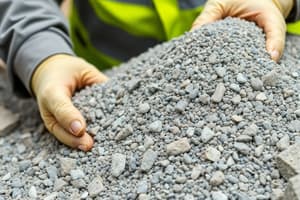Podcast
Questions and Answers
What is the main purpose of testing construction materials before use?
What is the main purpose of testing construction materials before use?
- To increase the cost of construction
- To enhance aesthetic appeal
- To identify potential problems (correct)
- To expedite the construction process
Which organization is recognized for standardizing material testing methodologies?
Which organization is recognized for standardizing material testing methodologies?
- International Construction Council
- Department of Public Works and Highways
- Philippine Bureau of Standards
- ASTM (correct)
What is a safety protocol mentioned for laboratory work?
What is a safety protocol mentioned for laboratory work?
- Wear safety goggles only during experiments
- Turn off all equipment after usage (correct)
- Always leave equipment running
- Prohibit first aid kit usage
Which of the following is a consequence of using sub-standard construction materials?
Which of the following is a consequence of using sub-standard construction materials?
What is the role of the Bureau of Research and Standards?
What is the role of the Bureau of Research and Standards?
Which of the following is NOT part of the safety protocol in the laboratory?
Which of the following is NOT part of the safety protocol in the laboratory?
Which type of wood is considered less suitable for high wind areas?
Which type of wood is considered less suitable for high wind areas?
What is the primary responsibility of the members involved in the development of ASTM standards?
What is the primary responsibility of the members involved in the development of ASTM standards?
What standard specification number corresponds to Portland cement?
What standard specification number corresponds to Portland cement?
Which of the following ASTM standards pertains to the determination of particle size distribution in aggregates?
Which of the following ASTM standards pertains to the determination of particle size distribution in aggregates?
What is prohibited in the laboratory setting according to the guidelines?
What is prohibited in the laboratory setting according to the guidelines?
How many countries have adopted ASTM standards?
How many countries have adopted ASTM standards?
What does ASTM C39 specifically test?
What does ASTM C39 specifically test?
What is the main role of a laboratory assistant or faculty member when operating the UTM and oven?
What is the main role of a laboratory assistant or faculty member when operating the UTM and oven?
Which ASTM standard method is used for determining the slump of hydraulic-cement concrete?
Which ASTM standard method is used for determining the slump of hydraulic-cement concrete?
Which process must occur first in the development of a new ASTM standard?
Which process must occur first in the development of a new ASTM standard?
What is the primary goal of the course mentioned in the content?
What is the primary goal of the course mentioned in the content?
Which construction materials are emphasized for testing in this course?
Which construction materials are emphasized for testing in this course?
Why is reinforced concrete commonly used for construction in the Philippines?
Why is reinforced concrete commonly used for construction in the Philippines?
What kind of structures typically use structural steel as a material?
What kind of structures typically use structural steel as a material?
What challenges do masonry structures face in the Philippines?
What challenges do masonry structures face in the Philippines?
What is a common characteristic of structural steel materials used in construction?
What is a common characteristic of structural steel materials used in construction?
How are masonry structures classified in terms of engineering?
How are masonry structures classified in terms of engineering?
What is an essential advantage of taking the DPWH-BRS Materials Engineering examination?
What is an essential advantage of taking the DPWH-BRS Materials Engineering examination?
What is the minimum requirement for the accreditation of materials engineers?
What is the minimum requirement for the accreditation of materials engineers?
What is the score threshold for automatic accreditation as Materials Engineer I?
What is the score threshold for automatic accreditation as Materials Engineer I?
What type of examination must all materials engineer applicants undergo?
What type of examination must all materials engineer applicants undergo?
Who is prohibited from taking the materials engineering accreditation examination?
Who is prohibited from taking the materials engineering accreditation examination?
Where is the practical examination for upgrading to Materials Engineer II conducted?
Where is the practical examination for upgrading to Materials Engineer II conducted?
What happens to applicants who score below 60% on the written examination?
What happens to applicants who score below 60% on the written examination?
Which of the following is true regarding the accreditation of foreign applicants?
Which of the following is true regarding the accreditation of foreign applicants?
Which aspect is covered in the practical examination for upgrading to Materials Engineer II?
Which aspect is covered in the practical examination for upgrading to Materials Engineer II?
What is the minimum score required in the Practical Examination for an Accredited Materials Engineer I to qualify as Materials Engineer II?
What is the minimum score required in the Practical Examination for an Accredited Materials Engineer I to qualify as Materials Engineer II?
What is the consequence for an Accredited Materials Engineer I who fails to upgrade to Materials Engineer II after two successive attempts?
What is the consequence for an Accredited Materials Engineer I who fails to upgrade to Materials Engineer II after two successive attempts?
What is the assignment limit for a Materials Engineer I on a single project?
What is the assignment limit for a Materials Engineer I on a single project?
How many projects can a Materials Engineer II be assigned if the aggregate cost does not exceed P300M?
How many projects can a Materials Engineer II be assigned if the aggregate cost does not exceed P300M?
What requirement must an accredited Contractors’/Consultants’ Materials Engineer fulfill to gain accreditation as a DPWH Materials Engineer?
What requirement must an accredited Contractors’/Consultants’ Materials Engineer fulfill to gain accreditation as a DPWH Materials Engineer?
What happens to DPWH engineers who score 60% or above but are separated from government service?
What happens to DPWH engineers who score 60% or above but are separated from government service?
How many projects with an aggregate cost of not more than P200M can a Materials Engineer I be assigned?
How many projects with an aggregate cost of not more than P200M can a Materials Engineer I be assigned?
What is a requirement for an accredited Materials Engineer to be automatically conferred the rank of Materials Engineer II?
What is a requirement for an accredited Materials Engineer to be automatically conferred the rank of Materials Engineer II?
Flashcards are hidden until you start studying
Study Notes
Course Goals and Importance
- Course aims to train students in standard testing procedures for common construction materials.
- Prepares students for the DPWH-BRS Materials Engineering examination, crucial for civil engineers in construction.
- Emphasizes testing materials (cement, sand, gravel, concrete, masonry, steel, wood) to assess physical and mechanical properties.
- Highlights importance of material testing to identify potential construction issues and ensure safety.
Construction Classifications in the Philippines
- Reinforced Concrete: Most commonly used due to cost-effectiveness; combines concrete with steel reinforcing bars.
- Structural Steel: Preferred for large warehouses and factories; includes hot-rolled steel like I beams and C Channels.
- Masonry: Typically used for bungalows; vulnerable to lateral forces, often considered non-engineered.
- Wood: Cost varies by type; safer against earthquakes but weaker in high winds; requires pre-use testing.
Standards and Specifications
- Materials testing is regulated by ASTM standards, widely adopted in the Philippines, with over 12,800 standards available in English and SI units.
- DPWH-BRS provides standard specifications for construction materials in public works projects.
- Usage of sub-standard materials is legally punishable.
Testing Standards and Methods
- Relevant ASTM standards include procedures for determining particle size, moisture content, and density for aggregates.
- Other key tests assess compressive strength of concrete and masonry specimens, ensuring material integrity and performance.
Safety and Laboratory Protocols
- Prioritizes safety; unnecessary tasks in the lab are prohibited, and proper equipment handling is mandated.
- First aid kits are available, and lab supervision is required when operating specific equipment like UTM and ovens.
- Cleanliness is essential; all equipment must be cleaned after use.
Accreditation and Examination for Materials Engineers
- Minimum requirement for accreditation: must be a registered and licensed Civil Engineer.
- Written examination grading converts raw scores to a percentage; Practical examinations assess real-world testing capabilities.
- Limits on assignments based on engineer classification (I or II) ensure manageable project oversight.
Project Assignment Limits for Engineers
- Materials Engineer I: Can oversee one project ≤ P150M, two projects ≤ P250M, or three projects ≤ P200M.
- Materials Engineer II: Can manage one project without cost limit or two projects ≤ P300M, or three projects ≤ P250M.
Key Regulations and Updates
- Department Order No. 098 Series of 2016 mandates adherence to DPWH specifications for all relevant infrastructure projects.
- DPWH guidelines prevent government engineers from engaging as private consultants while employed.
Conclusion
- Knowledge of testing standards, materials classifications, safety protocols, and accreditation criteria is vital for aspiring civil engineers in the construction industry.
Studying That Suits You
Use AI to generate personalized quizzes and flashcards to suit your learning preferences.




